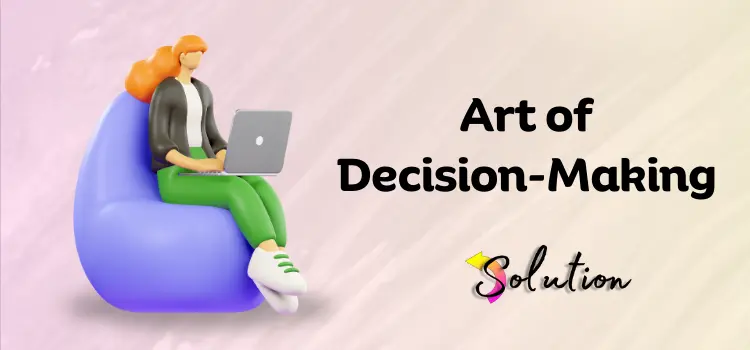
Making decisions for businesses is one of the most crucial aspects of running a successful company. Every decision, from financial and investment decisions to hiring the right employees, has a significant impact on the business’s overall success.
In today’s era, where decision-making power is becoming increasingly important due to rapid changes in technology and market trends, making better decisions is more critical than ever before. Most successful organizations today are those that have mastered the art of strategic decision-making, utilizing data-driven insights and forecasting techniques to stay ahead of the competition.
The Art of Decision Making: Tempted Sweet or Authentic Spicy?
What name should you give to the art of decision-making? Is it temptingly sweet or authentically spicy?
However, we used to refer to it as “garnishing the plate of mouth-watering platters,” with the platters representing the success of your business.
The art of decision-making is what determines your business’s success. Making decisions requires careful consideration of all factors and potential outcomes to ensure the business makes the best possible decision. It involves analyzing data, forecasting trends, and staying ahead of the competition to ensure success in the long run.
Ultimately, a delicate balance between creativity and strategy helps businesses determine their direction and set themselves apart from the rest. Businesses can adapt to changing market conditions by making timely and effective decisions, capitalizing on opportunities, and achieving sustainable growth. This is why mastering the art of decision-making is crucial for the success and longevity of any business.
A business strives to stay ahead of the competition by constantly evaluating its performance, identifying areas for improvement, and implementing innovative strategies that help it differentiate in the market.
Also Read – The Power of Money: Your Road to Financial Freedom
Understanding the Decision-Making Process
Did you even think decision-making was just a two-minute process involving sitting alone in a dark room and focusing on your mind? That may sound good in crime and mysterious movies, but it does not apply in the real world.
In reality, the decision-making process, especially in businesses, is complex and lengthy. It involves gathering information, analyzing data, considering various options, and weighing the potential outcomes before making a choice. To demystify this process, it’s important to break down the stages involved in the decision-making process:
1. Identifying the Problem or Opportunity
The heart of effective decision-making lies in the ability to accurately identify the problem or opportunity at hand. This initial step sets the foundation for the entire decision-making process and determines the direction of the decision. Without a clear understanding of the problem or opportunity, it’s impossible to make an informed decision that leads to a successful outcome.
Businesses must meticulously define the issue or goal, gather relevant information, and analyze potential solutions. This thorough understanding of the problem or opportunity will ensure that the decisions are well-informed and strategic, ultimately leading to more positive outcomes for the organization.
Also Read – The Power of Digital Marketing
2. Gathering Relevant Information
After identifying the problem, it’s time to gather relevant information from various sources, such as market research, data analysis, and expert opinions. You can also seek expert opinions and stakeholders’ input to gain a comprehensive understanding of the issue. This step is critical for ensuring that all possible factors are well considered before making a decision.
This collection of diverse information will give you a well-rounded perspective for making informed decisions, which will ultimately lead to the implementation of more effective solutions. This stage serves as a critical starting point for developing a strategic plan or course of action to address the problem. It will also help you better assess the situation and identify potential risks and opportunities associated with different options.
3. Generate & Evaluate Alternatives
Through brainstorming techniques like mind mapping or SWOT analysis, you can generate a variety of potential solutions. This step will help you be creative and innovative in exploring different approaches that you may not have considered otherwise.
By evaluating each alternative based on feasibility, cost-effectiveness, and potential impact, you can determine the best course of action. This systematic approach will lead to a well-thought-out and strategic solution to the problem.
Furthermore, evaluating each alternative will help you understand its pros and cons, as well as identify the potential risks or challenges associated with each alternative before proceeding with the implementation process.
4. Making the Decision
After weighing the pros and cons of each alternative, it’s time to consider the potential consequences and implications. Considering each decision’s long-term effects and potential ripple effects will help you make an informed and well-rounded choice that aligns perfectly with your goals and objectives.
Avoid rushing the decision-making process and spend time thoroughly analyzing and assessing all the available options before making the final choice. Involve the stakeholders in the decision-making process and solicit their input and feedback to ensure the consideration of all perspectives.
This collaborative approach will help you make an informed and successful decision, supported by all the parties involved.
Also Read – What Will AI do to the Business Landscape in 2024?
5. Implement & Monitor the Decision
It’s time to develop an action plan and timeline that outline the steps needed to implement the decision. Allocate the necessary funds and resources for the decision, and ensure that you have a system in place to monitor its progress and effectiveness. Additionally, it is crucial to regularly review and monitor the decision’s impact on key performance indicators, allowing for any necessary adjustments or improvements.
You can also gather feedback from the marketing or performance team and incorporate their insights into their decision-making process. Also, keep yourself mentally ready to adjust the action plan as needed based on the new information or changing circumstances. Remember that flexibility and adaptability are the key elements to successfully implementing and sustaining a decision.
The Last Suggestion
By understanding the different stages and components of the decision-making process, you can better anticipate potential challenges and proactively address them before they impact the outcome. We hope that by keeping these points in mind and following them while making crucial business decisions, you can boost the likelihood of achieving successful results and reaching your desired goals. Ultimately, keep yourself flexible and adaptable to navigate the challenges and bars caused by the uncertainties, and let the efficient outcomes drive your business towards growth and success.


